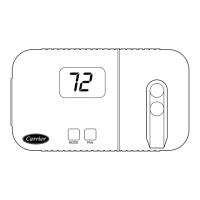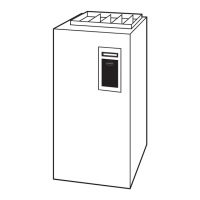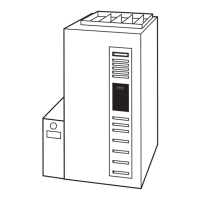PRESSURE SWITCH TUBING
One collector box pressure tube (pink label) is factory connected to
the pressure switch for use when furnace is installed in UPFLOW
or HORIZONTAL LEFT applications. This tube MUST be dis-
connected and used for the condensate trap relief port tube. The
other collector box pressure tube (green label) which was factory
connected to the condensate trap relief port connection MUST be
connected to the pressure switch in DOWNFLOW or HORIZON-
TAL RIGHT applications.
NOTE: See Fig. 14 or tube routing label on main furnace door to
check for proper connections.
Relocate tubes as described below.
1. Disconnect collector box pressure tube (pink label) attached to
pressure switch.
2. Extend collector box pressure tube (green label) which was
previously connected to condensate trap relief port connection
by splicing to small diameter tube (factory-supplied in loose
parts bag).
3. Connect collector box pressure tube (green label) to pressure
switch connection labeled COLLECTOR BOX.
4. Use remaining small diameter tube (factory-supplied in loose
parts bag) to extend collector box pressure tube (pink label)
which was previously connected to pressure switch.
5. Route this extended tube (pink label) to condensate trap relief
port connection.
6. Determine appropriate length, cut, and connect tube.
7. Clamp tube to relief port connection.
CONDENSATE TRAP FREEZE PROTECTION
Refer to Condensate Drain Protection section for recommenda-
tions and procedures.
CONSTRUCT A WORKING PLATFORM
Construct working platform where all required furnace clearances
are met. (See Fig. 3 and 12 or 13.)
UNIT MAY NOT OPERATE
Failure to follow this caution may result in intermittent unit
operation.
The condensate trap MUST be installed below furnace. See
Fig. 6 for dimensions. The drain connection to condensate
trap must also be properly sloped to an open drain.
NOTE: A 12-in. minimum offset pipe section is recommended
with short (5 to 8 ft) vent systems. This recommendation is to
reduce excessive condensate droplets from exiting the vent pipe.
(See Fig. 12, 13 or 42.)
LOCATION
Step 1—General
This furnace must
• be installed so the electrical components are protected from
water.
• not be installed directly on any combustible material other than
wood flooring (refer to SAFETY CONSIDERATIONS).
• be located so combustion-air and vent pipe maximum lengths
are not exceeded. Refer to Table 11.
• be located where available electric power and gas supplies meet
specifications on the furnace rating plate.
• be attached to an air distribution system and be located as close
to the center of the distribution system as possible. Refer to Air
Ducts section.
• be provided with ample space for servicing and cleaning.
Always comply with minimum fire protection clearances
shown on the furnace clearance-to-combustibles label. (See
Fig. 3.)
This furnace may be located in a confined space without special
provisions for dilution or ventilation air.
NOTE: For upflow/downflow applications install furnace so that
it is level or pitched forward within 1/2-in. for proper furnace
operation. For horizontal applications pitch 1/4-in. minimum to
1/2-in. maximum forward to ensure proper condensate drainage
from secondary heat exchangers. (See Fig. 15.)
When a furnace is installed so that supply ducts carry air circulated
by the furnace to areas outside the space containing the furnace,
the return air shall also be handled by ducts sealed to furnace
casing. The ducts terminate outside the space containing the
furnace to ensure there will not be a negative pressure condition
within equipment room or space.
FIRE, INJURY OR DEATH HAZARD
Failure to follow this warning could result in fire, property
damage, personal injury, or death.
Do not install furnace on its back. (See Fig. 16.) Safety
control operation will be adversely affected. Never connect
return-air ducts to back of furnace.
Fig. 15—Proper Condensate Drainage
A02146
UPFLOW OR DOWNFLOW HORIZONTAL
FRONT
LEVEL (0″)
TO
1
⁄2″ MAX
MIN
1
⁄4″
TO
1
⁄2″ MAX
FRONT
14

